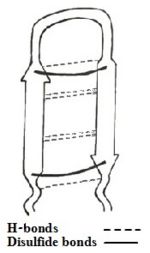Tachyplesin
From Proteopedia
(Difference between revisions)
| Line 17: | Line 17: | ||
The sequence adapts an antiparallel β-sheet (hairpin) conformation in solution, with a <scene name='67/671725/Beta_turn_tp-1/2'>β-turn</scene> for the centrally located residues <scene name='67/671725/Tyrargglyile/3'>Tyr-Arg-Gly-Ile</scene>, stabilized by two cross-strand <scene name='67/671725/Disulfide_bonds/4'> disulfide bonds </scene> between Cys³-Cys¹⁶ and Cys⁷-Cys¹²<ref name=Saravanan>PMID:22464970</ref><ref name=Nakamura>Nakamura, Takanori, et al. "Tachyplesin, a class of antimicrobial peptide from the hemocytes of the horseshoe crab (''Tachypleus tridentatus''). Isolation and chemical structure." Journal of Biological Chemistry 263.32 (1988): 16709-16713</ref>, and [http://en.wikipedia.org/wiki/Protein_primary_structure C-terminus amidation]. In addition there are H-bonds and aromatic rings stacking interactions which helps stabilize the hairpin loop structure of the peptide. | The sequence adapts an antiparallel β-sheet (hairpin) conformation in solution, with a <scene name='67/671725/Beta_turn_tp-1/2'>β-turn</scene> for the centrally located residues <scene name='67/671725/Tyrargglyile/3'>Tyr-Arg-Gly-Ile</scene>, stabilized by two cross-strand <scene name='67/671725/Disulfide_bonds/4'> disulfide bonds </scene> between Cys³-Cys¹⁶ and Cys⁷-Cys¹²<ref name=Saravanan>PMID:22464970</ref><ref name=Nakamura>Nakamura, Takanori, et al. "Tachyplesin, a class of antimicrobial peptide from the hemocytes of the horseshoe crab (''Tachypleus tridentatus''). Isolation and chemical structure." Journal of Biological Chemistry 263.32 (1988): 16709-16713</ref>, and [http://en.wikipedia.org/wiki/Protein_primary_structure C-terminus amidation]. In addition there are H-bonds and aromatic rings stacking interactions which helps stabilize the hairpin loop structure of the peptide. | ||
| - | TP-I undergoes a conformational change in the <scene name='67/671725/Tp_i_in_the_presence_of_lps/1'>presence of LPS </scene>. The backbone of the polypeptide becomes <scene name='67/671725/Conformation_change/ | + | TP-I undergoes a conformational change in the <scene name='67/671725/Tp_i_in_the_presence_of_lps/1'>presence of LPS </scene>. The backbone of the polypeptide becomes <scene name='67/671725/Conformation_change/6'>more rigid and twisted in the presence of LPS, than in the presence of water</scene>, making it more stable. |
Revision as of 12:59, 23 January 2015
| |||||||||||
References
- ↑ 1.0 1.1 1.2 Laederach A, Andreotti AH, Fulton DB. Solution and micelle-bound structures of tachyplesin I and its active aromatic linear derivatives. Biochemistry. 2002 Oct 15;41(41):12359-68. PMID:12369825
- ↑ 2.0 2.1 Chen, Yixin, et al. "RGD-Tachyplesin inhibits tumor growth." Cancer research 61.6 (2001): 2434-2438.
- ↑ 3.0 3.1 Saravanan R, Mohanram H, Joshi M, Domadia PN, Torres J, Ruedl C, Bhattacharjya S. Structure, activity and interactions of the cysteine deleted analog of tachyplesin-1 with lipopolysaccharide micelle: Mechanistic insights into outer-membrane permeabilization and endotoxin neutralization. Biochim Biophys Acta. 2012 Mar 23;1818(7):1613-1624. PMID:22464970 doi:10.1016/j.bbamem.2012.03.015
- ↑ Nakamura, Takanori, et al. "Tachyplesin, a class of antimicrobial peptide from the hemocytes of the horseshoe crab (Tachypleus tridentatus). Isolation and chemical structure." Journal of Biological Chemistry 263.32 (1988): 16709-16713
- ↑ Kushibiki T, Kamiya M, Aizawa T, Kumaki Y, Kikukawa T, Mizuguchi M, Demura M, Kawabata SI, Kawano K. Interaction between tachyplesin I, an antimicrobial peptide derived from horseshoe crab, and lipopolysaccharide. Biochim Biophys Acta. 2014 Jan 2;1844(3):527-534. doi:, 10.1016/j.bbapap.2013.12.017. PMID:24389234 doi:http://dx.doi.org/10.1016/j.bbapap.2013.12.017
- ↑ 6.0 6.1 6.2 Hong, Jun, et al. "Mechanism of Tachyplesin I injury to bacterial membranes and intracellular enzymes, determined by laser confocal scanning microscopy and flow cytometry." Microbiological research (2014).
- ↑ Yonezawa A, Kuwahara J, Fujii N, Sugiura Y. Binding of tachyplesin I to DNA revealed by footprinting analysis: significant contribution of secondary structure to DNA binding and implication for biological action. Biochemistry. 1992 Mar 24;31(11):2998-3004. PMID:1372516
- ↑ Lipsky A, Cohen A, Ion A, Yedidia I. Genetic transformation of Ornithogalum via particle bombardment and generation of Pectobacterium carotovorum-resistant plants. Plant Sci. 2014 Nov;228:150-8. doi: 10.1016/j.plantsci.2014.02.002. Epub 2014 Feb, 12. PMID:25438795 doi:http://dx.doi.org/10.1016/j.plantsci.2014.02.002
Proteopedia Page Contributors and Editors (what is this?)
Shulamit Idzikowski, Janak Raj Joshi, Michal Harel, Alexander Berchansky, Joel L. Sussman, Angel Herraez, Jaime Prilusky


